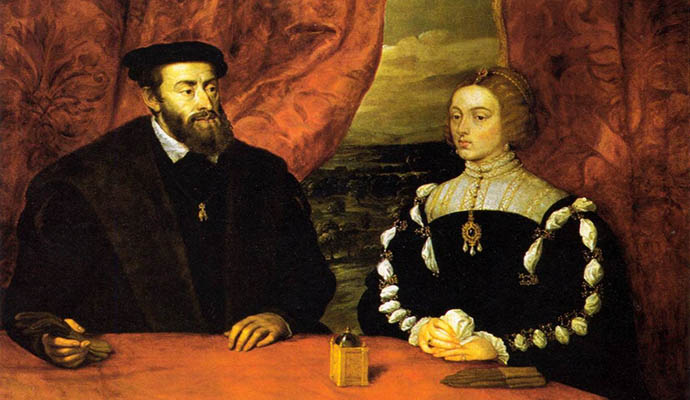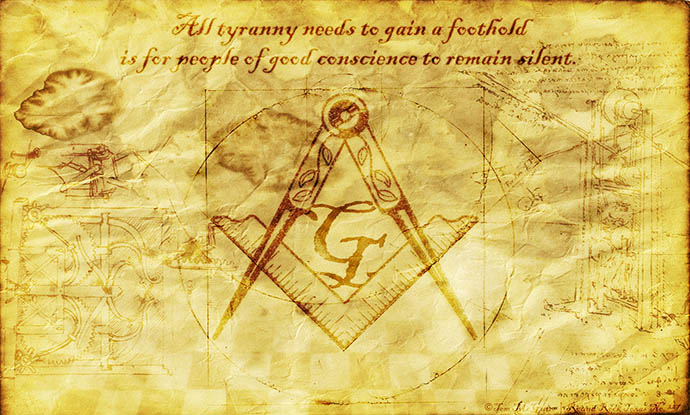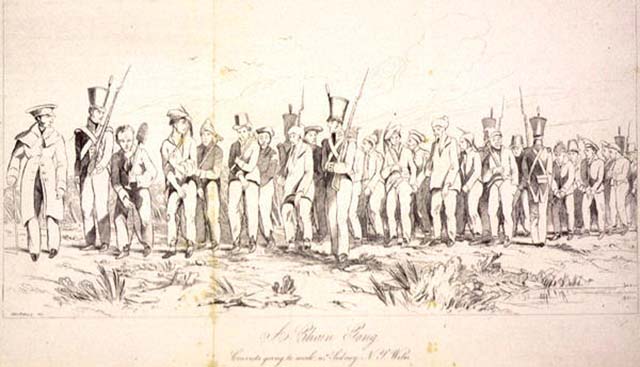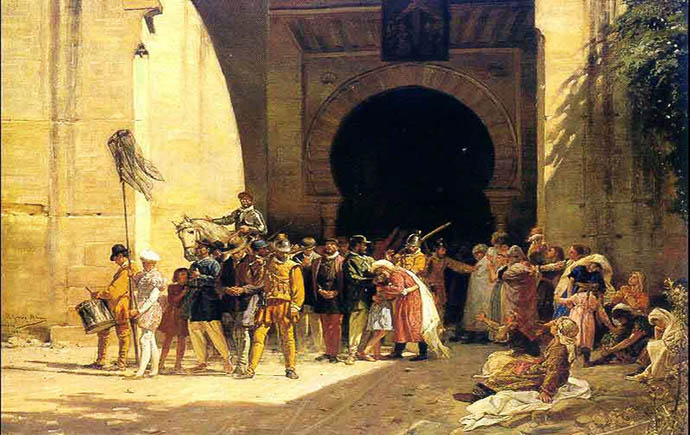
Beginning of the 16th century, early dawn of a capitalist era. The great geographical discoveries which opened before Europeans the doors to the new unknown worlds undermining foundations of medieval ideas of the person and the Universe. Time when the foundation for development of world trade, for transition from craft to manufactory production which allowed to take the huge advantages concealed in division of labor was laid. Decades of violent blossoming of bright, polichromatic culture of the Renaissance which was followed by weakening of thousand-year domination of Catholic church over all spheres of spiritual life. The begun formation of new bourgeois society was noted by a sharp aggravation of class fight. The powerful people’s movements developing into peasant wars became the response to strengthening of oppression from feudal lords. Revolts of a city plebs were multiplied. The royalty became the center of a regrouping of social forces. Relying on citizens, it led approach to feudal dissociation. France, England, Spain, some other countries Europe turned into the large national states. But forces of an old system were not going to yield the strengthened position in economic, social and political life, in the field of ideology and culture at all. Fully it affected also in the sphere of the interstate relations. The Western European historian V. Petri wrote in the book “False Ways of Europe”: “130 years between election of the emperor in 1519 (Charles V. – Bus) – when Germany made the decision in favor of Habsburg Spain and against France, – and the Westphalian world have much in common with meanwhile which we endured recently. There was a violent confrontation of political and religious ideas, fight of races was ruthlessly conducted, the great power tried to found the world empire and after the wars continuing decades suffered defeat from which could not recover”. The beginning of the Reformation coincides with election on a throne of the Sacred Roman Empire of Charles V who inherited crowns of four dynasties – Burgundy, Austria, Castile and Aragon; later passed to his successors also domination over Hungary, the Czech Republic and Portugal – and it apart from enormous colonial possession in America (where just at this time the Spanish conquistadors occupied immense lands of the newly opened continent), in Africa and Asia. Acquisition of huge prestige – even out of direct link with the real power which was possessed by the head of the Sacred Roman Empire was connected with an imperial title. This traditional prestige in itself was a considerable factor in fight Gabsburgov for hegemony in Europe. Charles V externally resembled that the giant powerful, full of determination a little on a game with what it was drawn by the artists flattering it. It was the ugly little man with pryshchevaty skin and always a half-open mouth – a physical defect which he hid under a short small beard. From tendencies of the emperor contemporaries noted gluttony which even induced the father to exempt in the form of courtesy the emperor from a post before a participle and which led to early gout. It was supplemented with addiction to tales of chivalry which hero he imagined himself moreover love to flowers and choral singing. Strengthening of the imperial power was for Charles V not only the purpose, but also means to achievement of a cherished dream about creation of the universal monarchy – successors of Ancient Rome or Charles the Great’s empire. Charles V consciously tried to give to the empire “supranational” character, not to emphasize its Spanish basis and communication of the plans of creation of the universal monarchy with Castilian tradition of crusades against Moors. The poet – Charles V’s contemporary and the participant of wars against France – Hernando de Assouna so defined this program of the world monarchy: “One monarch, one empire and one sword”. Trying to obtain election as the German emperor, Charles V in the confidential letter formulated opportunities which will appear at it as a result of acquisition of this title: “We will be able to make many kind and great acts. And not only to keep and protect the possession granted to us by god but also in huge degree to increase them, providing with such way silence and tranquility of the Christian world, maintenance and strengthening of sacred Catholic belief which is our main basis”. And the chancellor of the emperor Mercurio Gattinar repeatedly repeated that Karl is allocated with the Supreme power over the world as it “was spread on a kingdom by god, is predicted by prophets, uplifted in sermons of apostles, authorized by the birth, life and our Christ Christ Redeemer’s death”. Soon after Karl’s election on the German throne in 1519 Gattinara wrote it: “Your majesty, nowadays, when the Lord generously awarded you, having ennobled over all other Christian kings and princes to such an extent of power which was possessed hitherto only by your ancestor Charles the Great, you firmly get in the way to the universal monarchy, to subordinating all Christian world to one pastor”. The Pillars of Hercules – a way of Europe to the overseas countries were Karl’s coat of arms; the motto – plus ultra – is “farther and farther”. In April, 1521 Charles V declared to the Reichstag sitting at Vormsa: “For protection of the Christian world I decided to prozalozhit my kingdoms, possession and friends, my flesh and blood, soul and life”. (These motives in policy of the emperor also allow the latest western historians to represent his embodiment ideas of “unity of Europe”.) It seemed to contemporaries that there were certain chances for creation in Western Europe of the universal empire. Absolute monarchies – and especially Charles V’s state – had during this era the resources considerably exceeding those which were available at the disposal of the medieval kingdom. At the same time development of national consciousness did not progress so yet everywhere to cement resistance to plans of education by wars and dynastic combinations of the “supranational” states which were more or less coming to position of the dominating power in this part of the continent. Creation of the empire of Charles V almost coincided with the beginning of broad application of three major inventions: a compass by means of which opening and development of new trade ways and the statement of Europeans in immense territories of the New World became possible; the publishing which played so important role as the tool of ideological war, promotion of the century conflict, expansion of means of spiritual coercion in hands of inspirers and organizers of this conflict; the high-quality changes in military science which were extremely favorable for large powers and the strongest of them – Charles V’s empire. Withdrawal came from medieval tactics very quickly. Just at this time the infantryman receives firearms. Gotsper transfers words of some lord in Shakespearean “Henry IV”:
He very much regretted that from the earth
Dig out disgusting saltpeter,
Which to the blossoming beings
Brings death or damages health.
At the end of XV – the beginning of the 16th century French so improved guns that them became possible to deliver in the field of battle and to move in a course of action. These inventions were worked in troops of Charles V who entered also application of fronts – they allowed to turn in transit a two-wheeled gun into the four-wheel vehicle much more convenient for fast movement, especially on the rough country. Improvement by Spaniards of manual firearms – an arkebuz who was replaced with a musket was not less important. The arms muskets served as the beginning of century prevalence of the Spanish infantry. In 1494 two thirds of the French troops which at this time began a campaign to Italy were made by a knightly cavalry, and in 1528 – only the eleventh part. Also approximately the ratio of types of military forces and in the Spanish army changed. About 1521 the father Lev X defined cavalry duties: to cover troops, to provide delivery of provisions, to observe and collect prospecting data, to disturb the enemy. In this transfer of duties only participation in battles was missed. Charles V’s empire objectively was attempt of feudal society to find a convenient form of a political superstructure which at the same time would answer new economic conditions speaking to Marx’s words, “to trade requirements of the new world market created by great opening of the end of the 15th century” 7, more precisely. Over the world market the world empire Gabsburgov would be built on. However this attempt contradicted real tendencies of development as emergence of the world market created the acute rivalry between the European countries for dominant positions in world trade. Creation of the “supranational” empire of Charles V at the same time interfered with development of the new bourgeois relations in different parts of Europe. And at the same time huge financial expenditure which were made by Gabsburgami for the sake of achievement of a main goal – creation of the universal monarchy – and which became possible only as a result of operation of economic resources of the colonial empire of Spain in no small measure promoted growth of manufactory production, ripening of bourgeois way in the certain most developed regions of the Southern Germany, Holland, England and some other countries. The irony of history was that attempts of creation of the universal monarchy, being an invention of the most reactionary forces of Europe, led to creation of the mechanism which turned the Spanish colonial robbery into one of components of system of so-called initial accumulation of the capital. Idea of the universal Catholic empire it is possible with the basis to consider and as the answer of feudal reaction to rise at the end of the 15th century of movements of the peasantry and a city plebs in the German lands, in the cities of Flanders and Northern Italy (especially in Florence), in Catalonia and other regions of Europe. Though creation of the “supranational” empire of Charles V formally was a consequence of a number of dynastic marriages, in practice it answered aspiration of ruling class of feudal lords, and also tops of the burghers of a number of the countries to ensure protection and protection of the powerful central power as powerful tool of suppression of workers of masses. However in other parts of Europe where for this purpose there were historical conditions where, in particular, process of national consolidation came further, the developing “” absolutist monarchy had to carry out objectively same role. Hereditary possession Gabsburgov in the Central Europe and the Spanish state which resulted from association of Castile and Aragon (1479) and gains of Grenada (1492) were a basis of the empire of Charles V as it was already told, . But it is worth to remember that the centralized states at the same time were generally consolidated in England (after the end in 1485 of Scarlet and White Roza’s war) and France almost (after accession to royal lands from 1477 to 1491 Picardy, Burgundy, Provence, Brittany and some other historical French areas). Despite incompleteness of this process, on preservation of numerous remnants of the long period of feudal dissociation, the new centralized states had the uniform laws subordinated and the government controlled by the Supreme power, armed forces, powerful on era scales. Formation of the absolutist national states had till certain time and the known progressive value, liquidating feudal dissociation and creating an opportunity for development of the bourgeois relations. And Charles V’s empire regularly carried out functions of suppression of people’s movements which could accept nature of early bourgeois revolutions. In medieval Europe a certain step of a community of historical destinies, public institutes and culture found expression in unity of religion – an ideology form universal at that time, in existence along with national languages of Latin as language of diplomacy, theology and science, and also in such state and political educations as the Sacred Roman Empire and Catholic church. Emergence of the national states expressing peculiar features of a number of the European people did not cause disappearance of earlier developed lines of their ideological and spiritual community at all, though led to gradual falling of value of such “supranational” institutes as the empire and papacy. These forms of spiritual unity kept in a certain measure and the progressive beginning put in them (besides not destroyed by development of national culture of the European people at all) and, moreover, received a material support in shown at the beginning of a bourgeois era of a tendency peculiar to capitalism (along with a tendency to awakening of the nations) to internationalization as well economic life. However it does not belittle at all reactionary character of plans of those forces which tried to restore the become obsolete forms of the European community, such as a religious uniformizm and imperial universalism, restoration of church unity, domination of papacy and creation of the universal empire. France which then is most inhabited from the Western European countries also could apply for a role of the center of the pan-European monarchy. Its central situation in Western Europe – Spain, Italy, Germany and England were located around it – gave certain advantages in fight against rivals. These claims were put forward by already French campaign of 1494 to Italy which led to the French-Spanish wars for domination on the Apenninsky peninsula. Francis I got beaten in fight for an imperial throne in 1519 though he and was supported by the father Lev X. (Having convinced of it, the French king and the Roman high priest began to support the nomination of the duke Friedrich Saxonski, the patron Luther.) Charles V’s victory meant that on the land France almost from all directions it was surrounded with possession of the emperor and had to pass to defense. However the next four decades were filled with almost continuous wars between Gabsburgami and the French royal dynasty of Valois. The program of the universal empire met the obvious or hidden counteraction even in the center of possession of Charles V. Considerable number of the Spanish politicians of that time considered that Karl carries out imperial, but not national Spanish policy. But this course encountered direct resistance in Germany which full submission of the power of the emperor had to become the first and decisive step on its way to the all-European hegemony. Process of a raspadeniye of Germany on territorial principalities began long before the Reformation. Similar development is known also by history of other countries, but there the tendency to association, to creation of the national states won much earlier. In Germany process of strengthening of dissociation had deep social and economic roots, disintegration of purely feudal empire was followed by a gap between imperial lands. Representatives of centralization in the dissociation, carriers of local and provincial centralization, princes near whom the emperor more and more became the same prince, as well as all others” were the winner “. The concept of the German unity in the 16th century was expressed not in creation of the uniform state, and in cooperation of the states making “The sacred Roman Empire the German nation” and headed by the emperor who was elected to a life sentence by the most influential princes-Electors. Features of historical development of Germany led to the fact that in the 16th century there were enough no powerful internal forces which would support real unity of the country. Charles V tried to impose this unity from above, using resources of other possession. In case of achievement of this unity of Germany the role of one of parts of the universal empire of Gabsburgs would be prepared”. However the unity on the basis of a celebration of Catholic reaction in the European scale was so unattainable, as well as this empire. The social and economic reasons increasing dissociation created an opportunity for princes to effectively resist the emperor, using the Reformation for this purpose. Reformation was extremely difficult social phenomenon. It included, along with the burgher direction, its national current standing more to the left, and on the right – princely reformation. All these currents were distinctly shown in Germany during Peasant war of 1525. However after suppression of the country movement, direct impact on system of the international relations was exerted, first of all, by princely reformation. In other countries in the first half of the 16th century the statement of Protestantism had character of princely reformation too – so was both in England, and in Denmark, and in Sweden which kings, having torn with Rome and having confiscated possession of Catholic clergy, formed national churches. Their example caused the concealed envy in the monarchs keeping voluntarily or forcedly fidelity to Catholicism. Such “ordered” character of the Reformation originally weakened and softened influence of its victory in the certain countries on system of the international relations, and it affected fully only later, at full development of the century conflict.




Leave a Reply